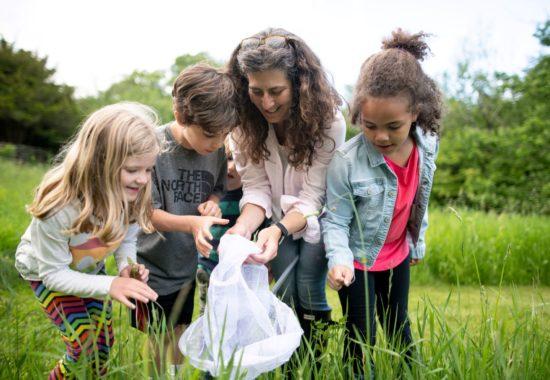- Tags:
- Wildlife,
- Education,
- Something Wild

Susie Spikol with young friends. (Courtesy photo)
"Something Wild" is joint production of NH Audubon, The Society for the Protection of New Hampshire Forests & NHPR. We recommend listening to it in its original format on NHPR but a transcript of the show is also below.
You can hear Something Wild on-air at NHPR every other Friday at 6:45 a.m. and 8:45 a.m., or subscribe to the Apple podcast here.
--------------------------------------------------
Susie Spikol, a naturalist at the Harris Center for Conservation Education in Hancock, is the author of “The Animal Adventurer’s Guide.” She spoke with Something Wild’s Chris Martin and Dave Anderson about her new book.
The book features activities to bring kids closer to wild animals and expands the idea of where — and what — wild animals are.
“You don't have to go anywhere special to find something wild. You can go out your back door or your front door," Spikol says. "You can look in the crack in a sidewalk. You can look at a forest, a stonewall. Even along the edges of roads and highways, you can find wild things. So I just wanted to get people thinking that nature happens everywhere."
People tend to emphasize "big wildlife," she says, "but I'm all about the little things that you can see… the ladybug in your house is just as wild as the eagle that you see flying.” Even the spider in the corner of the room? “Definitely wild!”
Spikol also encourages kids to go beyond “yuck!” Leeches are a good example.
“When we go ponding and we find a big juicy leech, a lot of it is like 'gross, ugh, it might get stuck on me,'" says Spikol. "But then when we stop and we look at the leech and really take the time to talk about and look at its body and see how it moves and its colors, it's actually really an incredibly beautiful creature.”
Spikol has spent a lot of time finding the value in something that might cause others to recoil.
“Around my neighborhood and in my community, people often refer to me as the Princess of Poop, which some people might take as something not so nice," she says. "But I love it! It is all about my scat collection, which I have been collecting since the early nineties. It's a great teaching tool. If you really want to know what an animal eats, take a good, hard look at what it excretes.”
One of the activities in her book is making a bug pooter —which, just based on the name alone, is bound to appeal to kids.
“It's actually a bug vacuum,” Spikol says. “I give directions on how to make this little bug vacuum out of a cup and some straws and a little bit of clay and some screens. And it's not like you're sucking the bug into your mouth, but you create the sort of vacuum that pulls the bug into the jar so you can catch the bug without touching it or hurting it or scaring it away.”
Spikol also makes note of the importance of getting close to nature.
”The actual physical act of being the person who's learning how to follow a frog, get up close, get quiet, bend down and catch it in your hand and then hold it, feel it's light body in your hand… that's really fundamentally different than watching it on a screen," she says. "And I think those experiences are the experiences that go right into your heart. And that's really what I hope my book does is, is help families and kids find access to that.”
